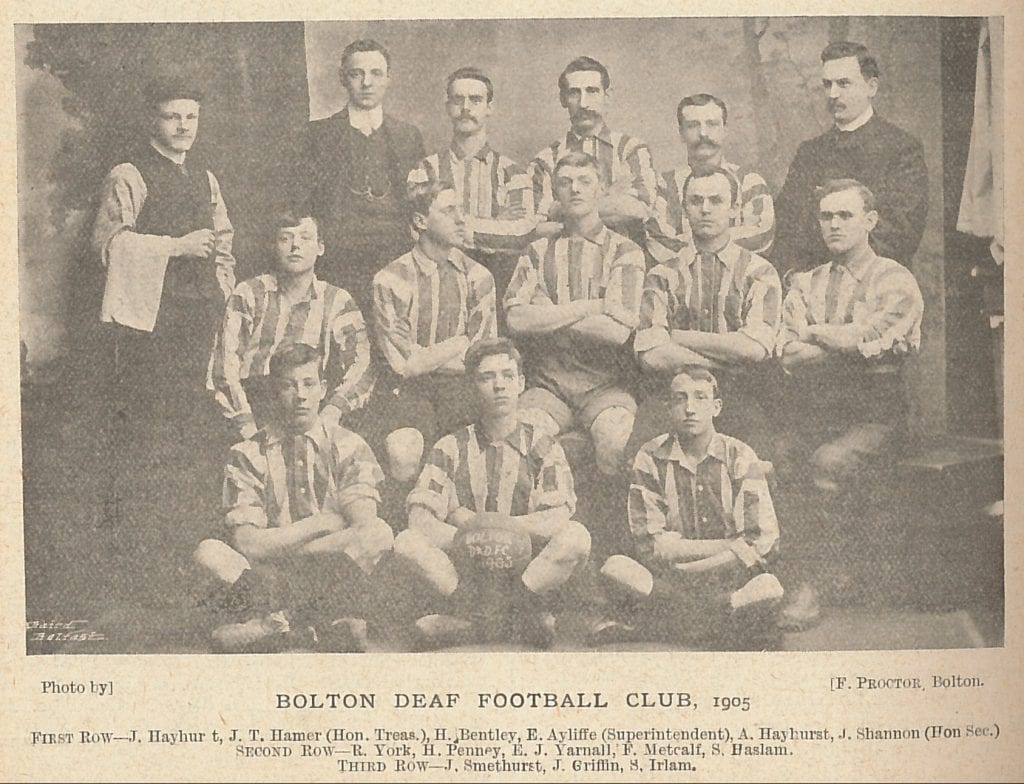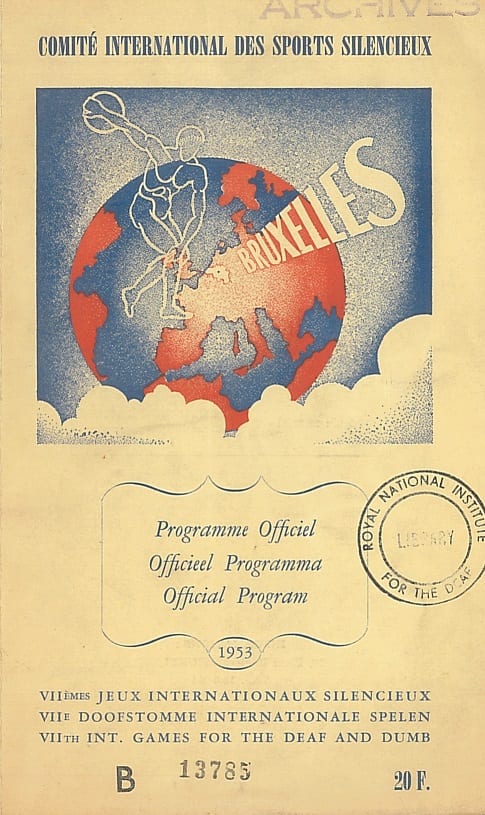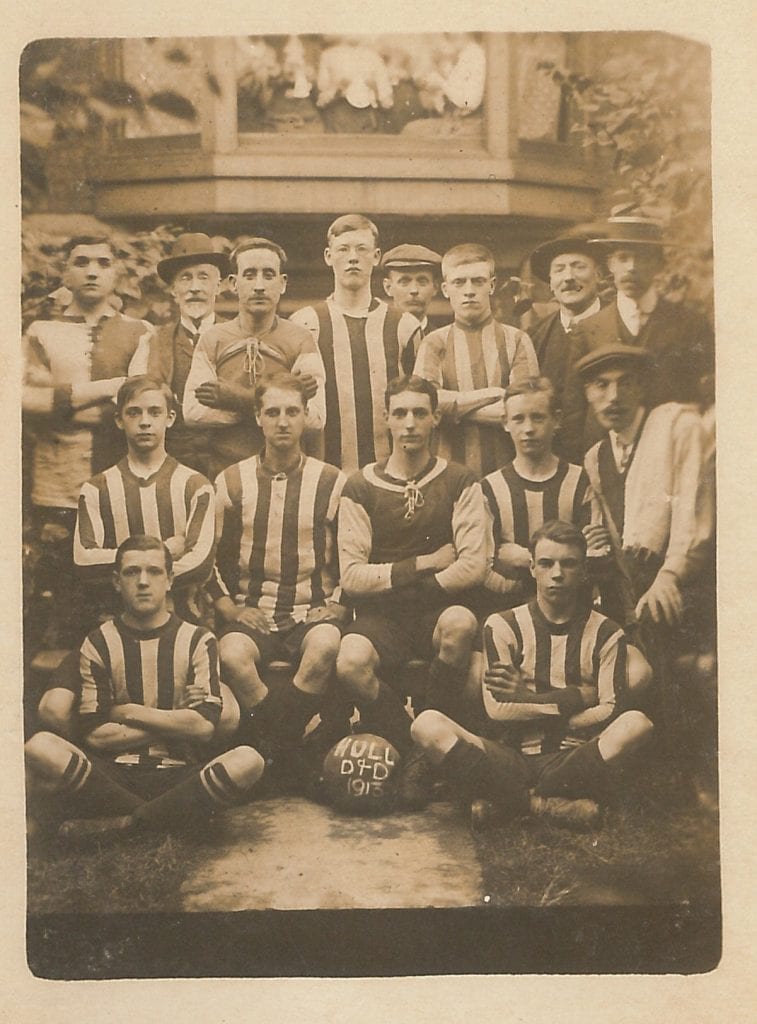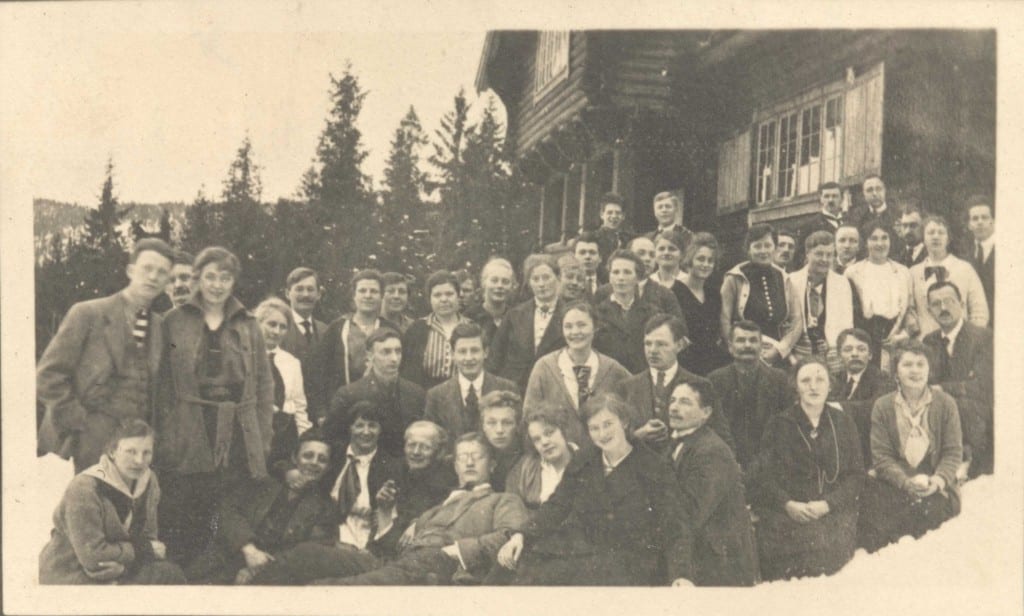The Bolton Deaf Football Club in 1905, pictures fourteen members. I thought it might be interesting to try and trace as many of them as we can. I immediately recognized Ernest Ayliffe in the back row, so I will leave him out as he has already featured in these web pages. He took over as Bolton missioner after Ernest Abraham left for Australia, assisted by John Shannon. Shannon left for Chester in 1911, and Ayliffe for Liverpool in 1914 (Ephphatha p.630).
James Hayhurst: He was born in France, circa 1882, a British subject, and in 1905 he would have been 23/4. In the 1901 census he was living at 8 Latham Street, and is described as an apprentice clog maker, ‘Deaf and Dumb from childhood’.
 1901 – James Hayhurst Class: RG13; Piece: 3627; Folio: 33; Page: 24
1901 – James Hayhurst Class: RG13; Piece: 3627; Folio: 33; Page: 24
Ernest John Yarnall was born in 1883, son of George, a mill furnace man at an ironworks, and his wife Ann, both of whom were originally from Staffordshire. He was apprenticed as a carpenter in 1901, and was living in Bridgman St. with his parents and sister Edith. The 1911 census tells us he was now a joiner, and had been deaf aged 10 or 11 months. In 1909 he married Annie Haslam, born 1880 who was deaf when aged three. I think Ernest died in 1954, but that needs checking.
1901 census Class: RG13; Piece: 3625; Folio: 136; Page: 7
1911 census Class: RG14; Piece: 23413
Samuel Haslam was a younger brother of Annie. They were born in Bradshaw where their mother Mary was a farmer. In 1901 Samuel was a wheelwright. Curiously he is not marked as deaf on the 1911 census, but the census information is not always complete and there can be degrees of deafness of course.
1901 census Class: RG13; Piece: 3615; Folio: 11; Page: 11
Samuel Irlam: He was Bolton born in 1889, and his mother, brother James and sister-in-law Sarah Ann were all deaf. He would have been about 16 when the photograph was taken. On the 1911 census form his mother wrote under infirmity, ‘Born from birth,’ ‘B from birth’, and ‘Deaf from birth,’ which is what she really meant. For her grand daughter she wrote ‘alright’. Samuel attended the Royal School in Manchester when William Nelson was headmaster, as did J.T. Hamer, Herbert Penn(e)y (try both spellings) and Joseph Griffin.
1911 census Class: RG14; Piece: 23321
A shortage of time restricted what I could research here – I hope to come back and add some more of the players, but if anyone has some information they can contribute, please put it in the comments space below.
Update: Our friend, historian Norma McGilp, has added this information she gleaned from the Manchester School records –
Manchester Deaf Institution records
James Hayhurst born 1880 – admitted 6 Aug 1890 – Bolton – father Warper. His brother, Allan Hayhurst (not in school record) (born 1875) m Clara Brindle – son Allan Brindle Hayhurst (1913-1981) of the BDA (Sec/Treas).
Joseph Taylor Hamer – born 26 April 1887, adm 22 Jan 1895, Turton, father dead.
Herbert Penney born 15 Sept 1885, adm 13 Aug 1894, Bolton, father tailor.
Ernest John Yarnall [Yarnell] born 3 Jan 1883, adm 12 Feb 1890, Bolton, father Furnace-man.
Samuel Haslam born 28 Feb 1881 – admitted 7 Aug 1889, Bolton, father farmer (siblings – Robert Haslam b 6 Nov 1877 adm 2 Aug 1887, Annie Haslam born 16 Apr 1880, admitted 2 Aug 1887).
Samuel Hamer born 16 Dec 1882, adm 4 March 1890 Ramsbottom, father labourer.
James Smethhurst b June 25 1880, adm April 1889 Macclesfield, father tailor.
Joseph Smethurst b 11 July 1883, adt 4 Aug 1891 Bolton, father labourer.
Joseph Griffin born April 18 1885, adm 13 Aug 1894, Broughton, father Musical Instrument maker.
Samuel Irlam born 11 May 1887, adm 7 Aug 1894, Bolton, father ‘Beetler at a croft’ (brother David Thos Irlam born Aug 7 1878 adm 1 Apr 1891, Hallwell, father a crofter).
BOLTON, BURY, ROCHDALE AND DISTRICT ADULT DEAF AND DUMB SOCIETY (1868-?)
Historical sketch. British Deaf Monthly, 1896, 6, 31-36. (photos of missioners)
History and work. Ephphatha, 1922, 52, 630-631.
The Messenger, vol.7 1904 p. 150 (photo)
 We are in the process of weeding our grey literature collection for the Action on Hearing Loss part of the collection. There is a wealth of good material, but it is hidden beneath a mountain of old photocopies of articles, mostly of dubious worth to our holdings. At one time the library catered many groups of people who were unable to use an academic library, so we had speech therapists as well as ENT doctors and teachers of the Deaf using the material. The Ear Institute part of our Library covers ENT fully and comprehensively, while UCL’s Language and Speech Science Library covers speech and language, and the Institute of Education covers, well, education! Therefore the Action on Hearing Loss collection focuses on Audiology, Sign Language, Deafness and related areas.
We are in the process of weeding our grey literature collection for the Action on Hearing Loss part of the collection. There is a wealth of good material, but it is hidden beneath a mountain of old photocopies of articles, mostly of dubious worth to our holdings. At one time the library catered many groups of people who were unable to use an academic library, so we had speech therapists as well as ENT doctors and teachers of the Deaf using the material. The Ear Institute part of our Library covers ENT fully and comprehensively, while UCL’s Language and Speech Science Library covers speech and language, and the Institute of Education covers, well, education! Therefore the Action on Hearing Loss collection focuses on Audiology, Sign Language, Deafness and related areas. The sort of things we are removing are broadly old and never consulted articles about, among other things, aphasia, stuttering and speech problems, and voice, dating from the 1950s to the 1980s. Many of these are online now, or held in print form elsewhere. In the process we are making happy discoveries, and we will gather some of the historical items into archive boxes to better preserve them.
The sort of things we are removing are broadly old and never consulted articles about, among other things, aphasia, stuttering and speech problems, and voice, dating from the 1950s to the 1980s. Many of these are online now, or held in print form elsewhere. In the process we are making happy discoveries, and we will gather some of the historical items into archive boxes to better preserve them. These will now be put into an archive box together.
These will now be put into an archive box together.
 Close
Close














